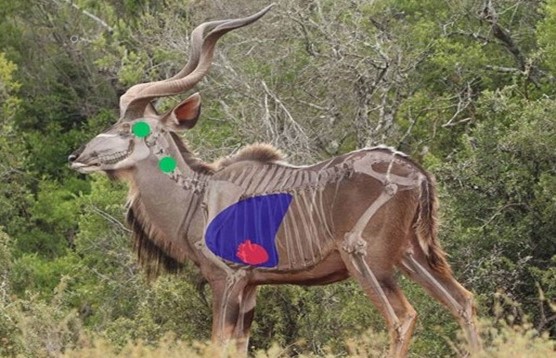Game hunting is a privilege, Hunters have a special responsibility to humanely stop the heart of one of God’s creatures and this can never be taken for granted.
A large majority of African plains game hunters believe the Kudu bull (Tragelaphus strepsiceros) to be the pinnacle of game hunting and is a prized trophy.
This beautiful antelope is recognized by its elegant appearance and long spiral horns. The female Kudu, being dainty, feminine and petite, does not have any horns.
Kudu are diurnal and Kudu hunting is best done in the early morning, or late afternoon. During the hotter hours of the day, Kudu can be found resting under the shade provided by Africa’s magnificent Acacia trees.
Kudus are very well known for their excellent hearing and their outstanding camouflage. This large antelope well deserves being known as “Africa’s Grey Ghost.”
These remarkable antelope are also respected for their ability to jump and clear great heights. A Kudu bull, from the stationary position can springboard itself over seven feet in the air.
Interesting detail about the Kudu.
[DYNAMIC-BLOGTABLEOFCONTENT]
Fundamental requirements when perfecting Kudu Shot Placement
Game hunting, whether for plains game or dangerous game has a few critical demands on the hunter in order to ensure a successful hunt, namely:
- Ability to execute precision shots.
- Skill
- An in-depth understanding of the animal’s anatomy.
- Making the correct choice with regards to rifles and ammunition.
The key to ethical hunting is the ability of the hunter to ensure that the first shot is well placed ensuring a quick and humane kill. No hunter wants to rush a shot, causing suffering and agony. A Kudu bull is well known for its resilience.
In order to execute a clean kill, the hunter needs to understand the anatomy and physical characteristics of the Kudu and know exactly where to place that first bullet.
Kudu Vital Organs for Shot Placement
When trophy hunting a Kudu bull, the African outfitter will recommend that the shot penetrate and hit the vital organs, namely the heart or lungs, the heart being the primary target.
These vital organs are situated deep within the chest cavity, with the heart sitting quite low behind the front shoulder. A mistake often made when hunting Kudu is placing the bullet too high, or too far behind the shoulder, missing the heart and entering the lungs.
Missing the “Sweet Spot” on shot placement
A good friend of ours, Dawie hunted this Kudu bull on our ranch in Limpopo, South Africa.
As you can see, the first bullet went in high, and too far back. Dawie was using his favorite 30.06 loaded with Peregrine 180 grains. The first shot was taken at roughly 200 yards. The net result was covering miles of spoor over the next thirty hours. As can be seen from the terrain, it was tough going walking up and down these ridges in the rocky environment.
Following the blood, sweat and tears, Dawie is now an expert regarding Kudu Shot Placement.
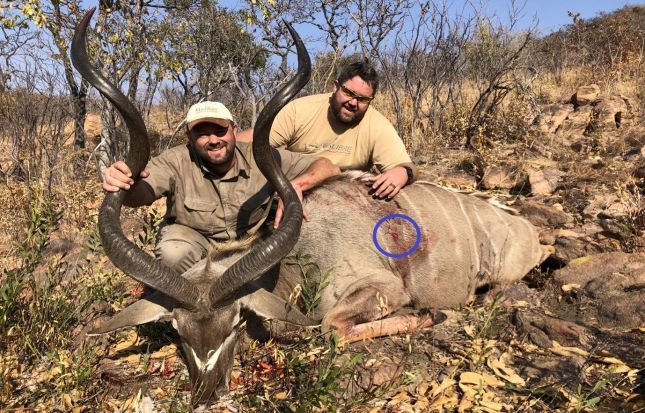
Factors to Consider when “lining up” for the Perfect Shot
Africa hunts for game antelope are challenging. Very seldom does a Kudu bull stand around presenting the hunter with the perfect shot. Kudu, with their long legs and being browsers often inhabit the highest ridges seeking cover in the brush. They are easily “spooked,” and the hunter very rarely has much time to consider all the logistics to execute the perfect kill shot.
With Kudu hunting, events unravel at a quick pace and the hunter needs to be able to make the decision, to shoot or not in a split second. Again, we reiterate the importance of shot placement when hunting Kudu, so cognizance needs to be taken of the below:
The Angle of the Shot
Considering the angle of the shot is critical, measuring the elevation of the Kudu between the hunter and the antelope is critical. The trophy Kudu may be standing away at a distance of 200 yards but may be elevated at a height of 100 yards (which often is the case).
Drawing an imaginary line between the hunter and the Kudu, it is obvious that the point of penetration would now need to be a little lower compared to the flat trajectory of a broadside shot at even height.
Placing the bullet a little high will pass over the heart into the lungs, while this will still result in the Kudu expiring, it will not be a quick and humane kill.
The Vital Organs position withing the Chest Cavity
A trophy Kudu bull presents the hunter with a few additional challenges. With the long legs of the Kudu, and considering the terrain Kudu love to occupy., the Kudu’s front and back legs may not always be straight down but may be “stretched out.” Additionally, Kudu love to twist their necks and head positioning looking in all directions. This, combined with the fact that they love the cover of scrub and bush makes it a challenge to determine exactly where the vital organ, namely the heart is position.
Many years ago, I was on a hunting safari in the Waterberg mountains, Limpopo, South Africa.
It was late in the afternoon and the below Kudu bull was standing about 150 yards out, on a ridge. The angle between myself and the kudu was about 15 degrees.
The Kudu bull was hidden in a little brush and as you can see from the trees and grass, he was perfectly camouflaged.
Lining up for the shot, to me (and my professional hunter) he was standing perfectly broadside, so I drew the line to the heart, aimed, and gently squeezed the trigger.
When we recovered the Kudu, I found that the Kudu bull had actually been standing facing away, and the bull had turned his entire head around to look back at us. So, what I thought was a perfect “broadside shot,” was actually a “Texas heart shot.” Luckily, I had taken the shot with my .458 loaded with 500 grain expanding bullets which went through all the vitals, from the rear!
African hunts for Kudu are not always simple and straight forward. Even the best “call” can often present unique challenges and problems, but a successful Kudu hunt is most rewarding and makes for any excellent hunting adventure.
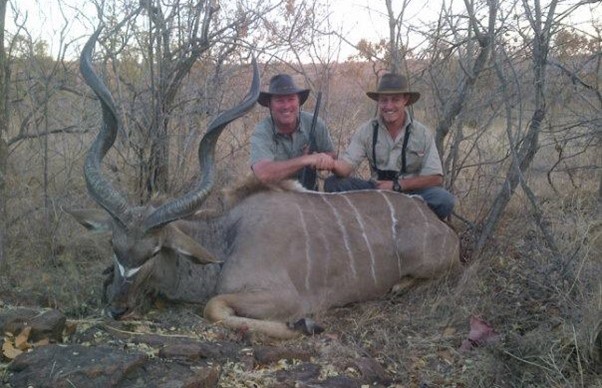
Where do you aim when shooting a Kudu?
Africa hunts for Kudu will be sure to present the hunter with a few options in terms of shot placement, all need to be carefully considered before squeezing the trigger.
The Broadside Heart Shot
With the Kudu presenting a broadside shot, this choice in my opinion is the most favored, reducing risk and a clean hit will ensure the Kudu does not suffer.
A Kudu’s heart is slightly bigger than a man’s fist, making an excellent target size. The heart of a kudu standing broadside is situated just behind the front shoulder, sitting rather low. Aiming for third way up the shoulder, slightly behind, measured from the bottom of the chest to the top of the spine will get the job done.
If the shot is just a little to the left, a superior quality bullet made for penetration will break through the shoulder into the lungs.
Slightly right, will still result in an effective double lung shot. Too far too the right will result in the Kudu bull being “gut shot” and the hunter can be assured that from the moment of impact, this Kudu hunting adventure is going to start getting tough.
The need for the hunter to perfectly understand the Kudu anatomy cannot be overemphasized. At all times know exactly where the heart is sitting in the chest cavity and consider the trajectory of the bullet. The first bullet needs to anchor the Kudu.
This huntress shot this stunning Kudu cow while on her first hunting safari at our ranch in Limpopo, using a 30.06 loaded with 180 grain expanding bullets.
Hunting a kudu cow for a first choice of antelope would not have been the one I would have made, but as we know, we sometimes have to take what the bush provides us with and be grateful and humble.
As can be seen from the below imaged, the bullet was placed slightly high and a little far back, resulting in the heart being missed. The 180 grain, being expanding did material damage and luckily this Kudu cow was recovered only after an hour of tracking over flat and sandy areas making the blood trail relatively easy to follow.
An inch or two to the right, would have resulted in a gut shot Kudu cow.
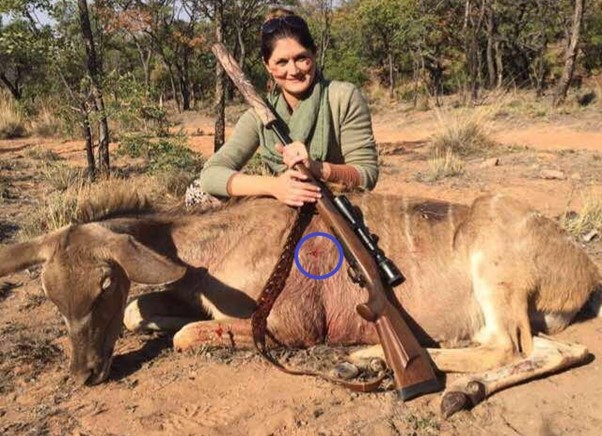
The Broadside Neck Shot
With the trophy Kudu bull standing broadside, this shot in my opinion is not the shot your professional hunter will advise you to take, unless there is no other choice and the hunter is looking at a sixty inch plus trophy bull, already thinking how good the Kudu is going to look in the trophy room.
The neck of a mature Kudu bull can become very thick and dense with sinew and muscle, often obscuring the path that the spine follows from the head through the rest of the body.
If there is no other option available, the hunter needs to aim at the spine where the head joins onto the body. Missing the spine will result in the bullet travelling through the flesh and sinew, making the chance of a successful recovery rather slim.
The Quartering – Away Shot
In the quartering away shot, the hunter is going to have to draw the imaginary line from the exit of the rifle to the point of bullet entry, through to the vital organs, preferably the heart. Aim for foreleg of the offside shoulder, using the inside line of the shoulder nearest the hunter. Know exactly the position of the heart within the chest cavity.
The Quartering – Towards Shot
As mentioned, a successful Kudu hunt is all about angles. A near miss in this position can lead to non-fatal shots. The possibility of saying “goodbye” to your trophy Kudu bull will be good.
Judge the height of the heart, place the bullet inside the shoulder nearest to you. Imagine the Kudu standing broadside and consider how low the heart is sitting, this will assist with getting the height correct. It would be better to consider waiting for the Kudu to possibly present a better angle into the heart.
The Frontal Heart Shot
Placing a bullet into the chest of the Kudu is considered as a “high risk” shot and should be considered when no other options are available. It is a tough decision to make, especially considering that this trophy Kudu bull, could possibly be “The One.”
The target area is small, and the bullet will need to penetrate deep into the chest to reach the vital organs. Aim in the center of the chest, just below the neck.
The risk for the hunter is that if the bullet is not perfectly placed in the center of the chest, i.e., a slight “pulled” or “pushed” shot, that the bullet may pass on the inside of the shoulder blades just missing the vital organs.
The below image shows ideal point of entry for the frontal heart shot. It can be noticed that the bullet is not in the center of the chest, as this Kudu bull is quartering.
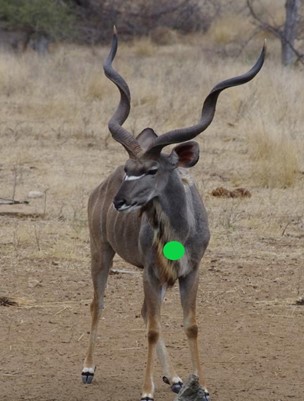
The Kudu Brain Shot
In my subjective opinion, the brain shot is by definition a problem and taking this shot is always a controversial issue.
A failed attempted brain shot, resulting in vitals not being hit, can become a hunter’s very worst nightmare. The result will be possibly shooting a horn off, or the upper/lower jaw or just “nicking” the antelope. It really is just terribly unnecessary suffering that this beautiful antelope has to endure.
A successful brain shot on a Kudu will result in the animal dropping in its tracks. A brain shot which hit the head but is missed in the brain is often called a “missed” shot. It is the responsibility of the hunter, who ultimately decided to take the shot to ensure that the animal is not wounded.
I have seen brave “Kudu Hunters” insisting on head shots and missing resulting in antelope walking for days suffering with missing jaws. Nothing like having to pay for the trophy fee while knowing your negligence caused the problem, food for thought.
Always know that while you may be aware of the exact position of the brain within the skull, the bullets’ part can be affected over long distances by other factors such as wind and mirage. In addition, the head is also the most mobile part of Kudu’s anatomy.
When safari hunting for trophy Kudu bull, the brain shot will not be a consideration by trophy hunters as the resulting damage will most certainly destroy the Kudu bull trophy.
To learn more about shot placement on large antelope.
Kudu Shot Placement when Bow Hunting
Bow hunting a trophy Kudu bull presents far more challenges that when hunting Kudu with a rifle. When bow hunting a Kudu, the hunter is going to have greater limitations, especially when considering the distance factor.
Shot placement is of paramount importance. The ideal target still remains just behind the shoulder, directly into the heart.
The ideal bow set up will be using a compound bow with a minimum draw weight of sixty pounds. The arrow, fitted with a razor sharp fixed broadhead should weigh between 450 and 500 grains.
What caliber is best for hunting Kudu?
A .270, 7mm or any 30-caliber rifle will work well.
It is not always about the caliber, but more about Kudu shot placement which ensures the success of a hunting safari.
How much will it cost to hunt a Kudu?
Hunting a Kudu bull is often included in a plains game hunting safari, which can cost between US $6000 and US $12000 depending on the during of the safari and the antelope included.
The standalone price for an average is on average between US $3000 and US $4000.
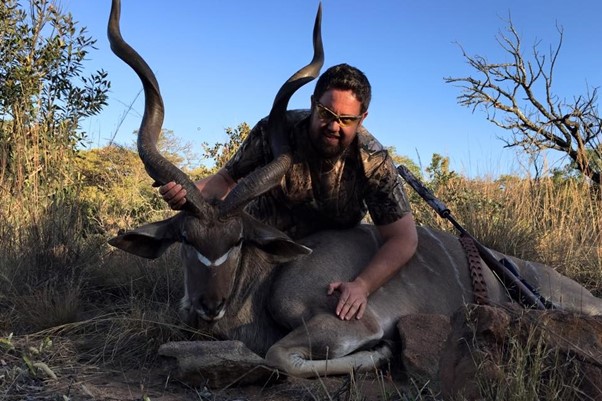
African hunts will always attract three types of hunters, namely:
- Those who admit to taking a poor shot and losing an animal.
- Thise who will still miss and lose an animal.
- And those hunters who lie (do not be this guy)
When in doubt, under no circumstance pull the trigger, unless its life threatening. Hunt with compassion and understand the value of life.
Read more about adventures in plains game hunting
Author: PC van Wyk
